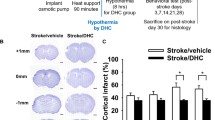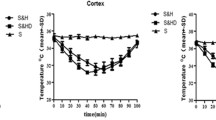Abstract
The significance of mild hypothermia as a therapeutic measure for ischemic brain damage is presented on the basis of different experimental results. An extracellular glutamate surge, a sustained activation of N-methyl-D-aspartate (NMDA) receptors, and an enhancement of DNA binding activity to transcription factor AP-1, all being key items directly linked to excitotoxic neuronal damage, are deeply affected by slightly lowering temperature (mild hypothermia [MH]). The cellular mechanism of MH seems rather nonspecific but tends to collectively involve these key items rendering neurons resistant to ischemic damage. Clinical application of MH should be a great challenge to relieve deadly effects on central neurons.
Similar content being viewed by others
References
Fay T. (1940) Observations on prolonged human refrigeration.NY State J. Med. 40, 1351–1354.
Kirino T. (1982) Delayed neuronal death in the gerbil hippocampus following ischemia.Brain Res. 239, 57–69.
Mitani A. and Kataoka K. (1991) Critical levels of extracellular glutamate mediating gerbil hippocampal delayed neuronal death during hypothermia: Brain microdialysis study.Neuroscience 42, 661–670.
Mitani A., Andou Y., Matsuda S., Arai T., Sakanaka M., and Kataoka K. (1994) Origin of ischemia-induced glutamate efflux in field CA1 of the gerbil hippocampus: An in vivo brain microdialysis study.J. Neurochem. 63, 2152–2164.
Ogata T., Nakamura Y., Shibata T., and Kataoka K. (1992) Release of excitatory amino acids from cultured hippocampal astrocytes induced by a hypoxichypoglycemic stimulation.J. Neurochem. 58, 1957–1959.
Pulsinelli W. A., Brierley J. B., and Plum F. (1982) Temporal profile of neuronal damage in a model of transient forebrain ischemia.Ann. Neurol. 11, 491–498.
Rothman S. M. and Olney J. W. (1986) Glutamate and the pathophysiology of hypoxic-ischemic brain damage.Ann. Neurol. 19, 105–111.
Shimada N., Graf R., Rosner G., Wakayama A., George C. P., and Heiss W.-D. (1989) Ischemic flow threshold for extracellular glutamate increase in cat cortex.J. Cereb. Blood Flow Met. 9, 603–606.
Yoneda Y., Ogita K., Inoue K., Mitani A., Zhang L., Masuda S., Higashihara M., and Kataoka K. (1994) Rapid potentiation of DNA binding activities of particular transcription factors with leucine-zipper motifs in discrete brain structures of the gerbil with transient forebrain ischemia.Brain Res. 667, 54–66.
Author information
Authors and Affiliations
Rights and permissions
About this article
Cite this article
Kataoka, K., Mitani, A., Yanase, H. et al. Ischemic neuronal damage. Molecular and Chemical Neuropathology 28, 191–195 (1996). https://doi.org/10.1007/BF02815222
Received:
Accepted:
Published:
Issue Date:
DOI: https://doi.org/10.1007/BF02815222




